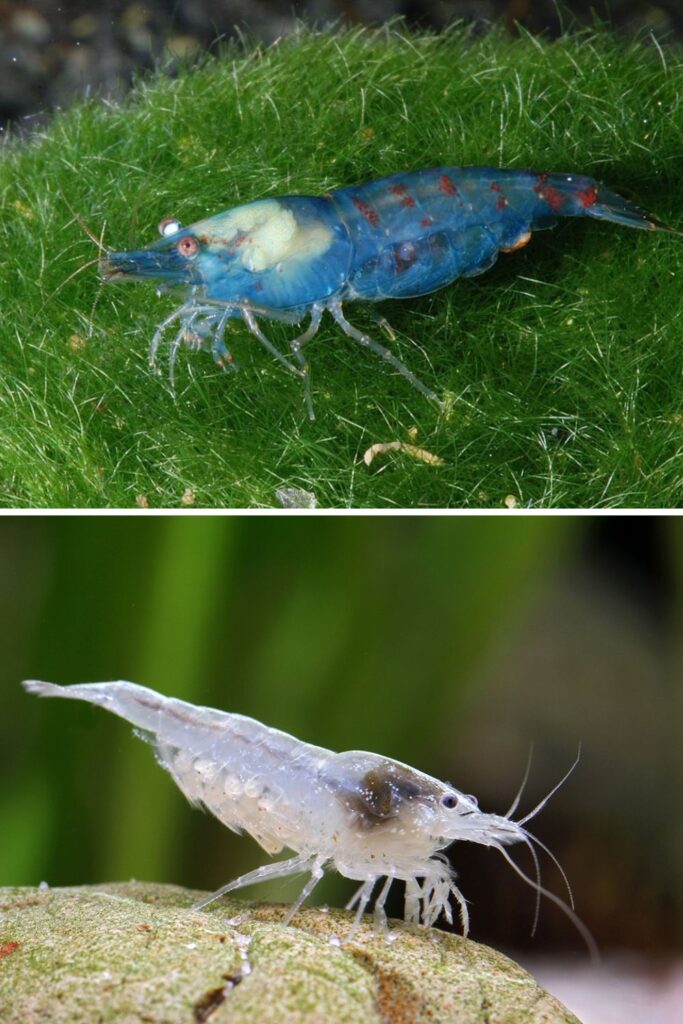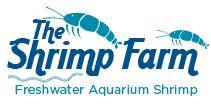Blue pearl shrimp | Neocaridina zhangjiajiensis "Blue Pearl" care & info
Looking for a beautiful blue shrimp to add to your aquarium, but don't want to go for a fussy species? You could opt for one of the many blue Neocaridina davidi dwarf shrimp varieties, but we'll admit that those are a very standard choice. So today, let's keep things intereting by highlighting a different blue Neocaridina: Neocaridina zhangjiajiensis "Blue Pearl" (better known as the blue pearl shrimp).
Keep reading for everything you need to do about blue pearl shrimp care and keeping this dwarf shrimp in your home aquarium!
| Scientific name | Neocaridina zhangjiajiensis, sometimes Neocaridina palmata |
| Common names | Blue pearl shrimp |
| Difficulty level | Easy |
| Origin | China |
Table of Contents
Blue pearl shrimp origins & appearance
The blue pearl is the result of selective breeding for blue coloration, first presented to the world in 2006 by German shrimp breeder Ulf Gottschalk. Its color is usually described as an icy blue, sometimes with hints of red on parts of the body. Gottschalk also presented the snowball shrimp at this time: a selectively bred white version of the same shrimp.
There's some confusion about the variety's wild ancestor. It's listed as Neocaridina palmata in some places and Neocaridina zhangjiajiensis (try saying that three times fast...) in others. This is because it was presented as zhangjiajiensis originally, but unofficially reclassified to palmata based on research done by the prominent German freshwater invertebrate researchers at Crusta10 around 2013. The reclassification seemingly never became official, though, so we'll stick with zhangjiajiensis here.
Whatever its name is, the shrimp used to breed blue pearls is likely naturally found in small streams and ponds in China.
Setting up a blue pearl shrimp aquarium
Requirements
The nice thing about blue pearl shrimp is that they're not very fussy at all when it comes to their environment. You don't need a large aquarium to keep these Neos: anything with a volume of five gallons or up should be fine. Just make sure the tank is fully cycled before you introduce any livestock.
Most shrimp enthusiasts prefer keeping their colored specimens on a black substrate. We recommend the same for your blue pearl shrimp, as the dark background will really make their colors pop!
Because shrimp are prey animals, they do appreciate a few hiding places in their tank. This doesn't have to be anything complicated. Some live aquarium plants are already great, and you can add some functional décor like shrimp flats.
Water quality
Blue pearls are not too demanding when it comes to water quality. They don't need special water values to thrive. Unless your tap water is totally out of whack, it can be used for these Neos with the help of a little water conditioner.
The most important thing is to just keep the water clean by ensuring the tank is cycled. Be sure to also perform weekly small water changes.
pH: 6.2-7.8
Temperature: 65-85 °F
GH: 3-7
KH: 1-8
Total Dissolved Solids: 75-150
Tankmates
Blue pearl shrimp are pretty prolific breeders, which means a population should usually be able to survive in peaceful community aquariums. Even if the occasional fry is picked off by fish, they should multiply quickly enough to make up for it.
If you want to focus specifically on breeding as many blue pearls as possible, it's best to keep them alone or with other invertebrates. Avoid Neocaridina davidi varieties like the popular red cherry shrimp. These will interbreed with your blue pearls and can cause unintentional hybridization.
Dwarf crayfish will co-exist peacefully with Neocaridina zhangjiajiensis. The same goes for small algae-eating snails like the red racer Nerite.
Blue pearl shrimp diet
Like other dwarf shrimp, blue pearls are detritus feeders, which is a polite way to say they'll consume anything they come across on the bottom of their tanks. They naturally feed on decaying plant matter, biofilm (micro-organisms), algae, and anything dead.
In the aquarium, there's not enough detritus to go around, especially once your blue pearl shrimp population has grown a bit. You should supplement their diet on a daily basis with a high-quality shrimp food. Aside from that, you can also feed a variety of extras, like blanched veggies, Indian almond leaves and much, much more.
Breeding blue pearl shrimp
The species in the Neocaridina genus are considered the perfect option for beginning shrimp enthusiasts looking at trying their hand at breeding for the first time. All you have to do is provide the right conditions. Offer good water quality and nutritious food, and the shrimp will take care of the rest.
To start things off, male shrimp will chase the larger females around the tank in a rather frenetic breeding frenzy. After this, you'll soon see the female begin to carry fertilized eggs between her back legs. She takes good care of them, fanning the eggs and picking out any that have succumbed to fungus.
After around 30 days, the baby shrimp will hatch. Unlike with some species, like the Amano shrimp, Neos produce fully developed (though very tiny) young. These will spend much of their time in hiding at first, but should start coming out more once they've grown a bit and molted a few times.
Buying blue pearl shrimp
Having been around since 2006, blue pearls are now a household name in the aquarium hobby. You should be able to find them at some aquarium stores, or they may be able to order a few in for you.
You can also easily buy blue pearls online. The Shrimp Farm sells blue pearl shrimp with live arrival guarantee and ships them right to your doorstep!
Frequently asked questions
Yes, you can, the two will tolerate each other's presence just fine. Do keep in mind that they can interbreed, which most aquarists consider undesirable.
This is highly dependent on the individual. Some Bettas will hunt dwarf shrimp relentlessly, while others mostly leave them alone. In any case, don't expect a thriving population; the shrimp offspring is bound to be eaten.
Blue pearl shrimp photo attribution: DirkBlankenhaus, CC BY-SA 3.0, via Wikimedia Commons



 Shrimp
Shrimp Fish
Fish Crab &
Crab & Plants
Plants Foods
Foods Snails
Snails
